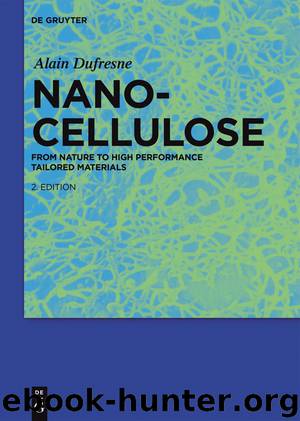Nanocellulose by Alain Dufresne

Author:Alain Dufresne
Language: eng
Format: epub
Publisher: De Gruyter
Published: 2018-03-16T04:00:00+00:00
6.7.3Effect of the presence of macromolecules
Depending on their concentration, cellulose nanocrystal suspensions exhibit three phases: isotropic phase at low concentrations, anisotropic phase at high concentrations and biphasic region at intermediate concentrations, where the isotropic and the anisotropic phases coexist. Thus, addition of high-molecular weight blue dextrans to these solutions would lead to preferential partitioning of dextran into one or the other phase (Edgar and Gray, 2002). Blue dextran is an easily quantifiable non-adsorbing macromolecule consisting of sulfonated triazine dye, Cibacron blue 3G-A, covalently bonded to the high-molecular weight dextran chains. Cibatron blue 3G-A is used as the dye molecule and when it is conjugated with dextran, then the dextran-dye conjugate is referred to as ligand. It was shown that adding dextran to an isotropic suspension caused no demixing of the two components. For a biphasic sample, absorption or preferential partitioning of dextran into the isotropic phase was observed and this effect increased with increasing cellulose concentration (Figure 6.15). Dextran absorbance into the anisotropic phase was considerably lower due to the mutual exclusion of the cellulose nanocrystal ordered domains and dextran molecules.
Fig. 6.15: Photographs of vials of biphasic cellulose nanocrystal suspensions with the same blue dextran concentration containing increasing concentrations from left to right of cellulose nanocrystal (A: 6.5 wt%, B: 8.8 wt%, C: 9.4 wt%, D: 11.0 wt%, E: 13.3 wt%), and showing the preferential partitioning of blue dextran into the upper isotropic phase (Edgar and Gray, 2002). Adding dextran to a completely anisotropic phase caused a phase separation into a dextran-rich isotropic phase and a dextran-poor anisotropic phase (Edgar and Gray, 2002). This phase separation occurred over a period of several days when the blue dextran macromolecules were added to the cellulose nanocrystal suspension. Higher concentrations of blue dextran led to faster separation and larger volume fractions of the isotropic phase. Further investigation of the phase separation behavior induced in highly anisotropic cellulose nanocrystal suspensions (13.8 wt%) by blue dextrans of varying dye content and molecular weight was reported (Beck-Candanedo et al., 2006a). It was shown that the phase separation was associated with the charged dye molecules bonded to the dextran. At increasing ionic strength, depletion attractions due to the blue dextran increasingly contribute to the phase separation. Moreover, addition of dextran induced distortions in the liquid crystal structure of anisotropic suspensions (Edgar and Gray, 2002). Similar results were obtained for the biphasic region. Due to mutual exclusion, dextran molecules migrated into the isotropic phase thereby increasing the osmotic pressure. The cellulose nanocrystals moved into the anisotropic phase (chiral nematic) in order to balance the osmotic pressure. This preferential migration in turn increased the width of the biphasic region.
Dye induced phase separation in anisotropic cellulose nanocrystal suspensions was also investigated using three different kinds of dyes, viz. anionic, cationic and neutral (Beck-Candanedo et al., 2006b). It was observed that anionic dyes of varying charge induced phase separation of an isotropic phase into a biphasic region at much lower ionic strengths than simple 1:1 electrolytes (sodium chlorite). Polyvalence and larger hydration radius were suspected due to their higher effectiveness in inducing phase separation.
Download
This site does not store any files on its server. We only index and link to content provided by other sites. Please contact the content providers to delete copyright contents if any and email us, we'll remove relevant links or contents immediately.
Alchemy and Alchemists by C. J. S. Thompson(3292)
The Elements by Theodore Gray(2851)
The Club by A.L. Brooks(2745)
How to Make Your Own Soap by Sally Hornsey(2739)
Drugs Unlimited by Mike Power(2478)
Wheels of Life by Anodea Judith(1917)
Cracking the Sat French Subject Test, 2013-2014 Edition by The Princeton Review(1761)
Perfume by Jean-Claude Ellena(1733)
The Flavor Matrix by James Briscione(1711)
The Cosmic Machine: The Science That Runs Our Universe and the Story Behind It by Scott Bembenek(1693)
Cracking the LSAT, 2012 Edition by Princeton Review(1688)
MCAT Physics and Math Review by Princeton Review(1566)
1000 Multiple-Choice Questions in Organic Chemistry by Organic Chemistry Academy(1565)
Cracking the SAT Premium Edition with 6 Practice Tests, 2017 by Princeton Review(1479)
The Thing Around Your Neck by Chimamanda Ngozi Adichie(1475)
Handbook of Modern Sensors by Jacob Fraden(1475)
A is for Arsenic: The Poisons of Agatha Christie (Bloomsbury Sigma) by Kathryn Harkup(1454)
Synchrotron Light Sources and Free-Electron Lasers by Eberhard J. Jaeschke Shaukat Khan Jochen R. Schneider & Jerome B. Hastings(1454)
Harry Potter All Books: 8 Books by J.k.rowling(1435)
